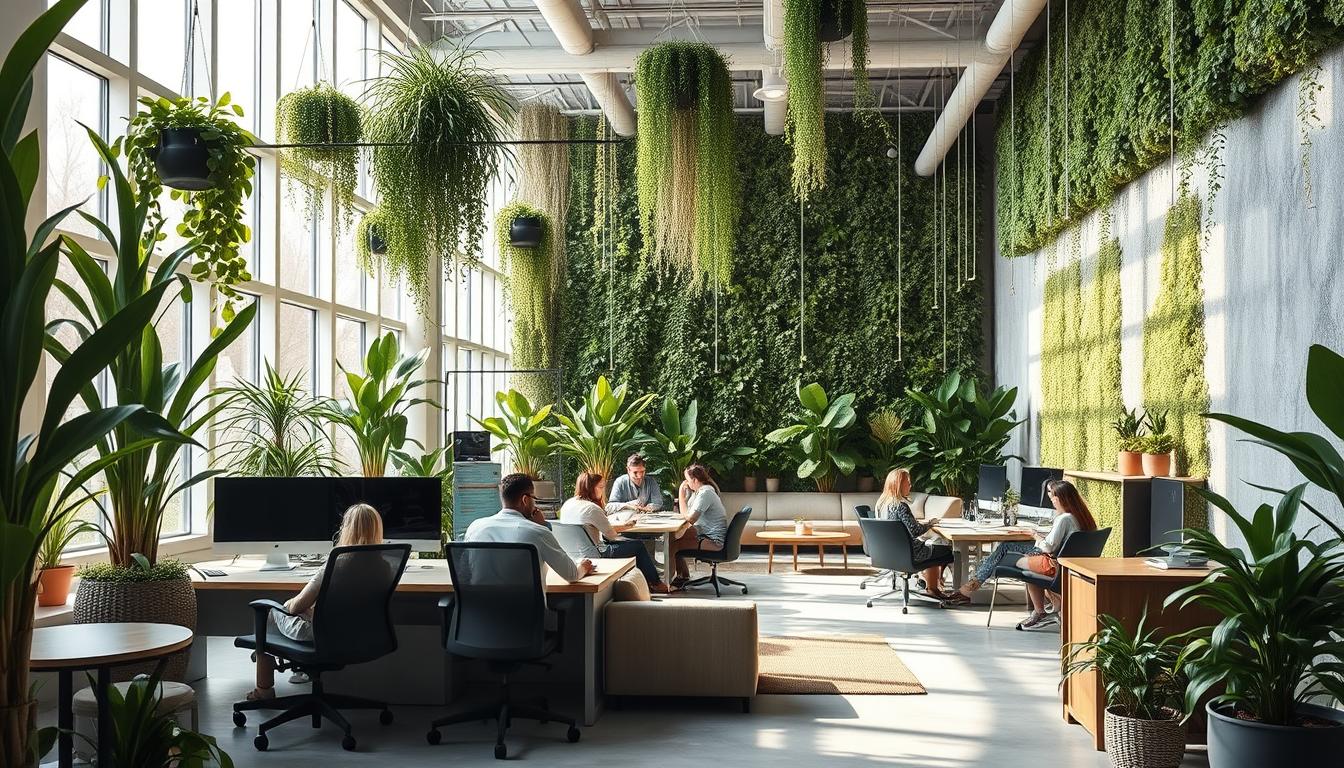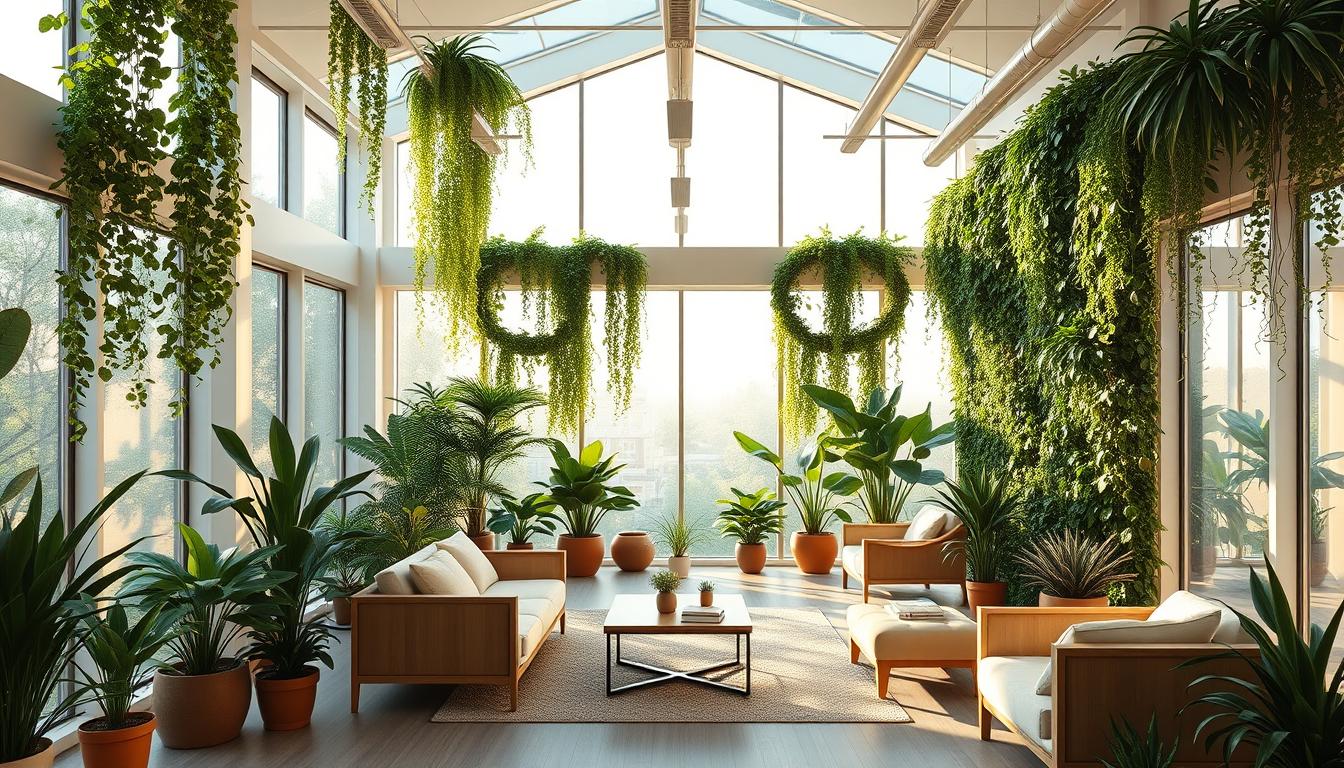Recently, the effect of indoor plants on air quality has gotten a lot of focus. Studies show that indoor plants might help us by making the air better. They do this by removing harmful chemicals called volatile organic compounds (VOCs) from the air. These chemicals can cause health problems.
Many people believe in the power of plants to clean indoor air. But new research makes us wonder how effective they really are. This section looks at how indoor plants impact air quality. We’ll look at different views and what science says about it.
Understanding Indoor Air Quality Issues
Indoor air quality affects our health and happiness. Everyday items can emit dangerous chemicals, like volatile organic compounds (VOCs), into our homes and workplaces. These can make the air we breathe toxic.
Common Indoor Air Pollutants
Some pollutants, like formaldehyde and benzene, are especially harmful. They come from:
- Paints and varnishes
- Cleaning products
- Furniture and carpets
- Air fresheners and other fragrances
Coming into contact with these pollutants can cause breathing problems and allergies.
Sources of Indoor Air Pollution
To make indoor air cleaner, we need to know where pollution comes from. Key sources include:
- Building materials that give off VOCs.
- Cleaning products with dangerous chemicals.
- Appliances used for cooking and heating.
- Problems like pests and mold.
Knowing about these pollution sources helps keep our air clean and healthy.

Historical Context: NASA’s Pioneering Study
In the late 1980s, NASA looked into using indoor plants to clean the air in space stations. This important study from 1989 searched for plants that could remove harmful chemicals, called VOCs, from the air. The results changed how people see the role of plants indoors.
Key Findings of NASA’s Research
NASA found certain plants, like golden pothos and spider plants, are great at cleaning the air. These plants can lower the levels of harmful VOCs. This led to more interest in gardening at home and living in a sustainable way. People learned about the power of plants to purify air, which excited homeowners and those who care about the environment.
Influence of NASA’s Study on Public Perception
Thanks to the study, people started to see indoor plants as more than just decoration. They are key for cleaning the air. NASA’s work made having plants in homes, offices, and schools more popular. Now, more people want to grow houseplants, knowing they can make indoor air better.
Indoor Plant Impact on Air Quality
Indoor plants are crucial for better air quality. They remove harmful chemicals called volatile organic compounds (VOCs). Some plants are really good at cleaning the air, making indoors healthier.
Plants that Remove Common VOCs
Some plants are famous for their ability to clean the air. Here are a few:
- Chrysanthemums: They can remove different VOCs like benzene and formaldehyde.
- Gerbera daisies: These flowers are not just pretty but are also great at filtering out toxins, including trichloroethylene.
- Spider plants: Known for being tough, spider plants help remove harmful substances and improve air quality.
Factors Affecting the Effectiveness of Indoor Plants
The way plants clean the air depends on several things:
- Number of Plants: Having more plants usually means better air cleaning. To really reduce VOCs, you need several effective plants.
- Size of Indoor Space: Bigger rooms might need more plants to clean the air well.
- Plant Maintenance: Plants that are healthy and taken care of well do a better job at cleaning the air. Keeping them in good shape maximizes their cleaning power.
Research Controversies Surrounding Plant Efficacy
Recently, many have debated if indoor plants truly improve air quality. Studies show mixed results about how effective plants are. A key study in 2019 revealed these mixed findings by analyzing a lot of research.
Meta-Analysis of Plant Studies
A detailed study looked at many reports on air quality and indoor plants. It showed plants help remove harmful compounds. But, you’d need a huge amount of plants at home to match lab clean air levels. This finding made people doubt the common belief about houseplants.
The Discrepancy Between Lab and Real-World Conditions
The talk also covers differences between lab conditions and real-life. Studies in perfect lab settings don’t match our home environments. Things like light, humidity, and air movement affect how well plants work. This makes us question if what works in labs works at home too.
The Role of Plants in Carbon Dioxide Absorption
Indoor plants are key in taking in CO2. This helps lower greenhouse gases, creating healthier places to live and work. Through photosynthesis, plants change CO2 to oxygen. This cleans the air. When picking plants for indoors, it’s good to know how well they can absorb CO2. This way, you get the most health and beauty benefits.
How Plants Absorb CO2
Plants pull in CO2 from the air through tiny holes in their leaves, called stomata. Inside the plant, CO2 becomes sugar and oxygen using sunlight. This process is good for the plants and makes indoor air cleaner by reducing CO2.
Comparative Efficiency of Different Plant Species
Not every plant is the same in CO2 absorption. Studies have found some plants are really good at taking in greenhouse gases. These include:
- Spider Plant
- Pothos
- Peace Lily
- Rubber Plant
- Areca Palm
Adding these plant types to indoor spaces can make a big difference in how much CO2 is absorbed. Each one has its own way of doing this. Some plants are just better for cleaner indoor air.
Potential Negative Effects of Indoor Plants
Indoor plants bring benefits but also challenges. Problems can arise from not taking care of them properly. Neglect can lead to mold and allergens, hurting the air inside.
Mold and Allergens from Overwatering
Too much water is a common error. It makes a good place for mold. This mold and moisture can make allergens that harm people with allergies or breathing problems.
Dust Accumulation on Leaves
Plants indoors get dusty. Dust stops the plant from making food through photosynthesis and might worsen the air quality. This can make breathing hard for some people. Cleaning the leaves well is key to keeping indoor plants healthy and lowering allergens.
Effective Strategies for Improving Indoor Air Quality
Improving indoor air quality is not just about adding plants. It includes steps like controlling pollution sources, better ventilation, and using air purifiers. These are key parts of a plan to make indoor air cleaner.
Source Control Methods
Begin by controlling pollution at its source. Reducing chemical use can cut down harmful air substances. Think about these tips:
- Choose non-toxic cleaners
- Lessen candle and air freshener use
- Don’t smoke inside
- Keep shoes outside to reduce dirt and bacteria
Ventilation as a Key Factor
Ventilation is crucial for cleaner indoor air. Letting in fresh air helps thin out indoor pollutants. To ventilate better, you can:
- Open windows for natural air flow
- Use fans in kitchens and bathrooms
- Keep air vents clear
Mechanical Air Cleaning Solutions
Mechanical air cleaners are a big help in purifying indoor air. HEPA filters, for example, catch tiny particles to ensure air is cleaner. Keep your HVAC and air purifiers in good shape for best performance. They’re vital for keeping air quality at its best.
Real-Life Implications of Indoor Plant Use
Adding plants to homes and work spaces has proven to bring big changes. These changes are not just about looks. They also make us healthier and more productive. Studies show that employees work better and feel better in green environments.
Case Studies Demonstrating Impact
Many studies back up the good things about having plants indoors. One famous study in a big office showed a 15% boost in how much work got done when plants were around. Another study, this time in a hospital, found that patients got better quicker thanks to cleaner air and a nicer environment.
Long-Term Benefits vs. Short-Term Expectations
The benefits of indoor plants are not just a quick fix for looks. They provide lasting health perks. Studies reveal less stress, happier people, and cleaner air indoors over time. It’s clear that plants offer real, long-term gains that increase as time goes by.
Conclusion
The link between indoor plants and clean air is complex and important. Many studies show that indoor plants can help remove harmful VOCs from the air. However, it is vital to pick the right plants and take good care of them. Poor maintenance can reduce their air-cleaning effects.
Adding plants to our homes should be part of a bigger plan for cleaner air. We also need to improve airflow, reduce pollutants at their source, and maybe use air purifiers. Mixing plants with these methods can make our indoor air much healthier.
Choosing and caring for indoor plants wisely can create a positive environment. Knowing how plants affect air quality can help us improve our health. We should always consider the bigger picture of keeping our indoor air safe.



